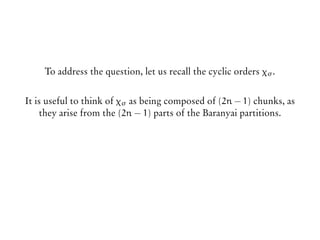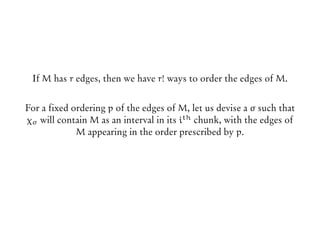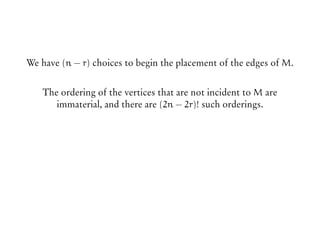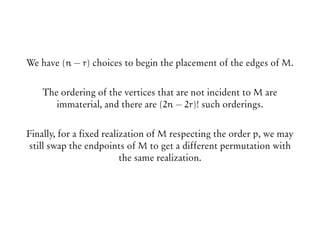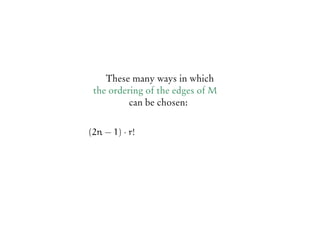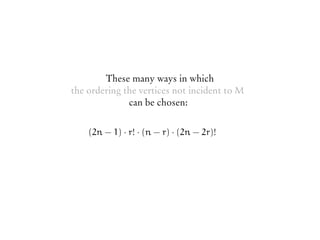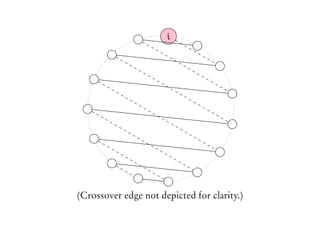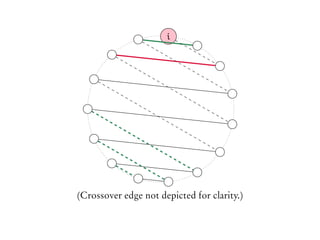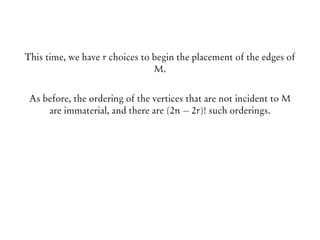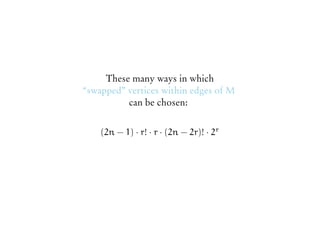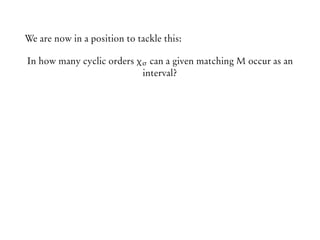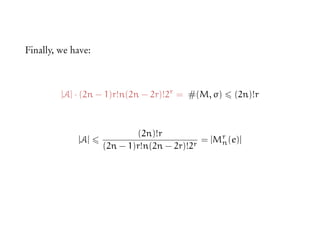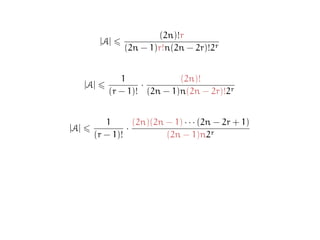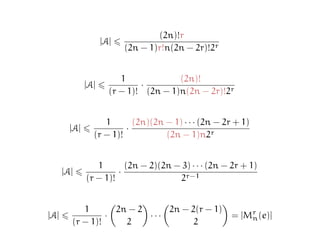The document discusses matchings in graphs and the Erdos-Ko-Rado (EKR) theorem. It introduces Baranyai partitions, which is a decomposition of the edges of a complete bipartite graph K2n into (2n-1) perfect matchings. Considering cyclic permutations of the edges within each perfect matching partition provides a way to set up "Katona-like local environments" to prove bounds on intersecting families of matchings, in analogy to Katona's proof technique for intersecting families of sets.
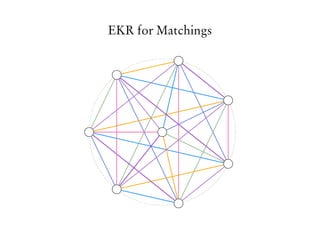




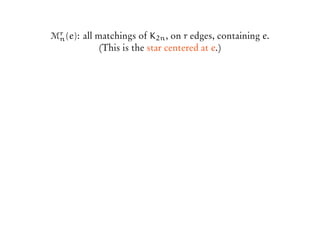


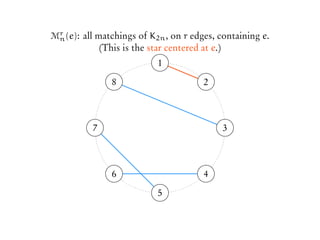



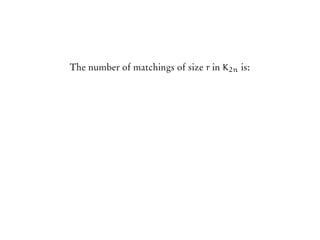








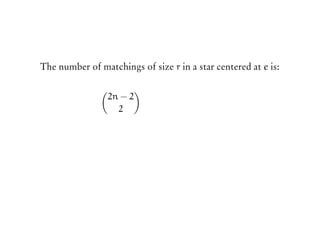




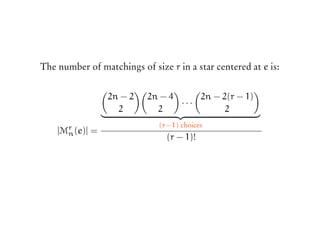



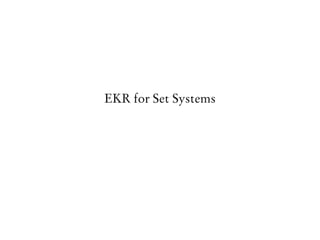

![The EKR Statement for Families of Sets
If A is an intersecting family of r-subsets of [n], then:
|A|
(
n − 1
r − 1
)
,](https://image.slidesharecdn.com/matchekrslides-130604211058-phpapp01/85/EKR-for-Matchings-33-320.jpg)
![The EKR Statement for Families of Sets
If A is an intersecting family of r-subsets of [n], then:
|A|
(
n − 1
r − 1
)
,
with equality holding if and only if A is a star.](https://image.slidesharecdn.com/matchekrslides-130604211058-phpapp01/85/EKR-for-Matchings-34-320.jpg)














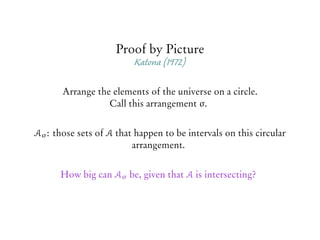

![The Count
Katona (1972)
How many pairs (S, σ) are there,
where S ∈ A, and σ is a cyclic permutation of [n]?](https://image.slidesharecdn.com/matchekrslides-130604211058-phpapp01/85/EKR-for-Matchings-51-320.jpg)


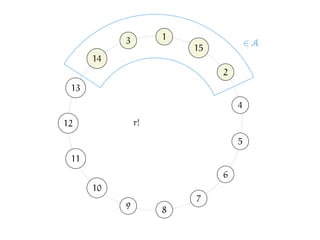



![The Count
Katona (1972)
How many pairs (S, σ) are there,
where S ∈ A, σ is a cyclic permutation of [n], and S occurs as an
interval in σ?](https://image.slidesharecdn.com/matchekrslides-130604211058-phpapp01/85/EKR-for-Matchings-58-320.jpg)
![The Count
Katona (1972)
How many pairs (S, σ) are there,
where S ∈ A, σ is a cyclic permutation of [n], and S occurs as an
interval in σ?
|A| · r! · (n − r)!](https://image.slidesharecdn.com/matchekrslides-130604211058-phpapp01/85/EKR-for-Matchings-59-320.jpg)
![The Count
Katona (1972)
How many pairs (S, σ) are there,
where S ∈ A, σ is a cyclic permutation of [n], and S occurs as an
interval in σ?
|A| · r! · (n − r)! (n − 1)!r](https://image.slidesharecdn.com/matchekrslides-130604211058-phpapp01/85/EKR-for-Matchings-60-320.jpg)
![The Count
Katona (1972)
How many pairs (S, σ) are there,
where S ∈ A, σ is a cyclic permutation of [n], and S occurs as an
interval in σ?
|A| · r! · (n − r)! (n − 1)!r
|A| (n−1)!r
r!(n−r)!](https://image.slidesharecdn.com/matchekrslides-130604211058-phpapp01/85/EKR-for-Matchings-61-320.jpg)
![The Count
Katona (1972)
How many pairs (S, σ) are there,
where S ∈ A, σ is a cyclic permutation of [n], and S occurs as an
interval in σ?
|A| · r! · (n − r)! (n − 1)!r
|A| (n−1)!r
r!(n−r)! =
(n−1
r−1
)
.](https://image.slidesharecdn.com/matchekrslides-130604211058-phpapp01/85/EKR-for-Matchings-62-320.jpg)



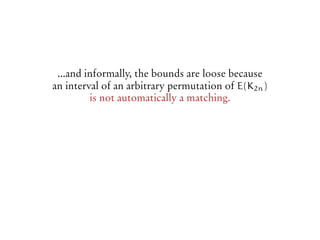







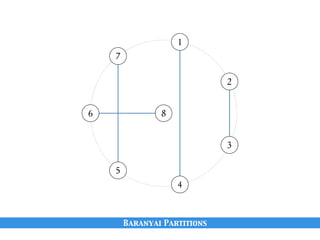

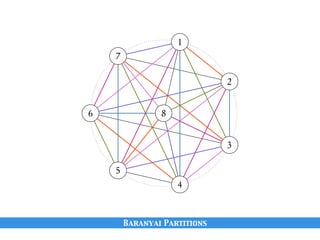



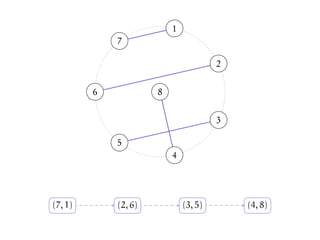





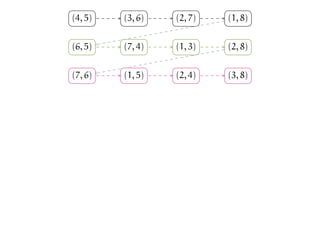

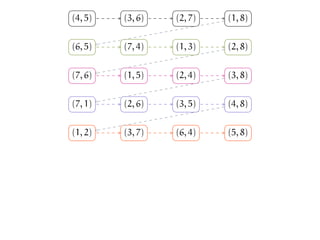


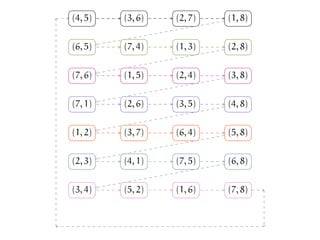


![We have just described one cyclic permutation of E(K2n).
We can generate other cyclic permutations of E(K2n) using this
method.
Let σ be a permutation of [2n].
Start with the following Baranyai Partition...
(illustration for n = 4):](https://image.slidesharecdn.com/matchekrslides-130604211058-phpapp01/85/EKR-for-Matchings-94-320.jpg)


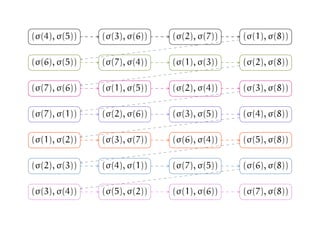
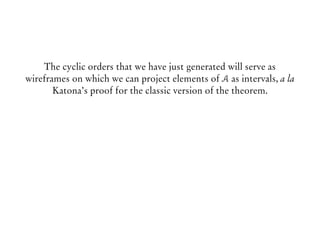








![Proving the EKR bound
Let A be an intersecting family of r-matchings of K2n, where r < n.
Let σ be a permutation of [2n] - consider the cyclic permutations
of E(K2n) that we generated based on σ - let’s call this χσ.](https://image.slidesharecdn.com/matchekrslides-130604211058-phpapp01/85/EKR-for-Matchings-107-320.jpg)
![Proving the EKR bound
Let A be an intersecting family of r-matchings of K2n, where r < n.
Let σ be a permutation of [2n] - consider the cyclic permutations
of E(K2n) that we generated based on σ - let’s call this χσ.
Aσ: those sets of A that happen to be intervals on this circular
arrangement.](https://image.slidesharecdn.com/matchekrslides-130604211058-phpapp01/85/EKR-for-Matchings-108-320.jpg)
![Proving the EKR bound
Let A be an intersecting family of r-matchings of K2n, where r < n.
Let σ be a permutation of [2n] - consider the cyclic permutations
of E(K2n) that we generated based on σ - let’s call this χσ.
Aσ: those sets of A that happen to be intervals on this circular
arrangement.
How big can Aσ be, given that A is intersecting?](https://image.slidesharecdn.com/matchekrslides-130604211058-phpapp01/85/EKR-for-Matchings-109-320.jpg)
![Proving the EKR bound
Let A be an intersecting family of r-matchings of K2n, where r < n.
Let σ be a permutation of [2n] - consider the cyclic permutations
of E(K2n) that we generated based on σ - let’s call this χσ.
Aσ: those sets of A that happen to be intervals on this circular
arrangement.
|Aσ| r, for the same reasons as before.](https://image.slidesharecdn.com/matchekrslides-130604211058-phpapp01/85/EKR-for-Matchings-110-320.jpg)

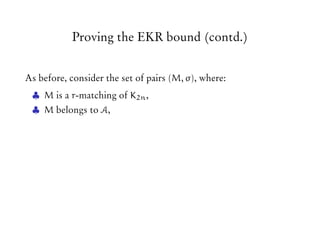
![Proving the EKR bound (contd.)
As before, consider the set of pairs (M, σ), where:
♣ M is a r-matching of K2n,
♣ M belongs to A,
♣ σ is a permutation of [2n],](https://image.slidesharecdn.com/matchekrslides-130604211058-phpapp01/85/EKR-for-Matchings-113-320.jpg)
![Proving the EKR bound (contd.)
As before, consider the set of pairs (M, σ), where:
♣ M is a r-matching of K2n,
♣ M belongs to A,
♣ σ is a permutation of [2n],
♣ and M occurs as an interval in χσ.](https://image.slidesharecdn.com/matchekrslides-130604211058-phpapp01/85/EKR-for-Matchings-114-320.jpg)
![Proving the EKR bound (contd.)
As before, consider the set of pairs (M, σ), where:
♣ M is a r-matching of K2n,
♣ M belongs to A,
♣ σ is a permutation of [2n],
♣ and M occurs as an interval in χσ.
Clearly,
#(M, σ) r · (2n)!](https://image.slidesharecdn.com/matchekrslides-130604211058-phpapp01/85/EKR-for-Matchings-115-320.jpg)


